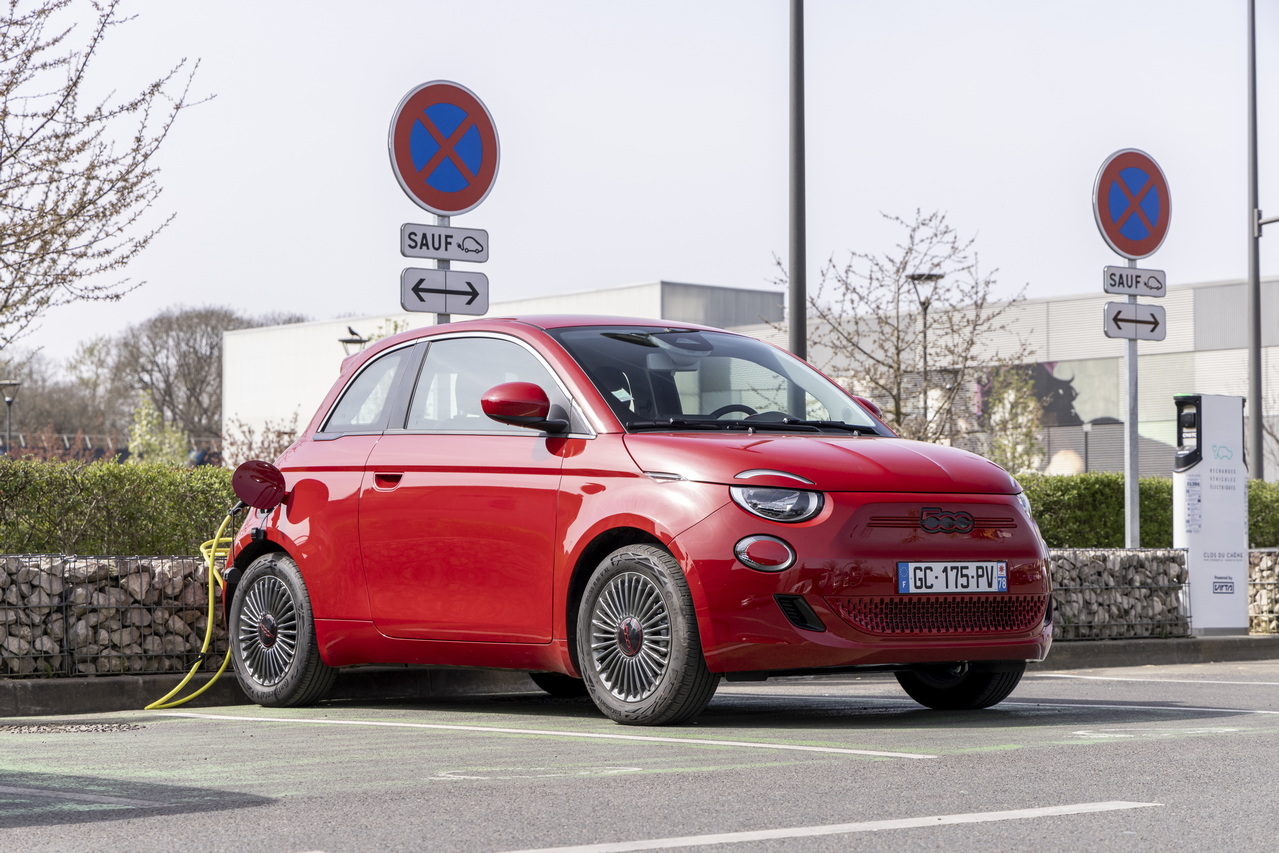
The Fiat 500 has a small 23.8 kWh battery which lowers its price but also its WLTP range to 190 km. This dapper Italian becomes one of the cheapest electric city cars on the market, but beware of its equipment if you do not check the RED finish.
Car tested: Fiat 500e RED
|
From€28,400
€6,000 bonus
|
Fiat writes this prominently on its website and in its advertisements. Its 500 electric is offered from €109 per month. Rather enticing for this city car which has lost none of its charm by switching to electricity and which is perfectly cut out for the city. To make this proposal, Fiat is based on the small battery version, which displays 23.8 kWh of power and 190 km of autonomy. This lowers the price of access to €25,400 in the Action front bonus finish, against €30,900 minimum for the higher model (42 kWh battery and 320 km of autonomy) in the Icon finish.
Fiat 500 electric price
The offer at €109 per month extends over a period of 37 months and 30,000 km. It is accessible without condition of recovery but requires a contribution of €2,500 excluding bonus. This proposal therefore concerns the low-range model, which may be sufficient depending on the use of the car, but you also have to be satisfied with the rather bare Action finish. Right here, no radio, no air conditioning, no touchscreen and small 15-inch wheels. Such stinginess in a new car becomes rare, especially compared to the price.

The RED finish of our test model is more dapper. The 7-inch touchscreen, radio, automatic climate control, Apple CarPlay and Android Auto come as standard, as do the soft-touch steering wheel, 16-inch rims and chrome window surrounds. Nicer, but also more expensive: count €28,400 before a bonus of €6,000 and a rent that climbs to €175 per month The promise of €109 is receding… and the difference will increase with each option checked, like painting metallic (the RED does not only exist in red!) or the charging cable for public terminals (see list on page 2). However, there is a way to contain the monthly payment for this electric 500 by lowering the mileage of the contract, because 10,000 km per year for an electric city car with low autonomy is a lot.
Driving
The electric Fiat 500 remains a Lilliputian with its size of 3.62 m, or 5 cm more than the gasoline version still in the catalog. Remember that the two models have nothing to do in terms of chassis and design. The new battery-powered model was designed on a modern platform dedicated to electric propulsion, while its thermal counterpart uses a chassis dating from 2009. The small size obviously works wonders in town, where the electric 500 is a delight to drive. . Its 95 hp engine with instant torque of 220 Nm allows quick starts and smooth evolutions. Maneuverability is ensured by a short turning circle (9.20 m) and steering that is both smooth and precise.

There are three driving modes: Normal, Range and Sherpa. They act on the engine force, therefore on the recovery of energy when lifting the foot from the accelerator. The choice will be made mainly according to his desires between freewheeling in Normal mode, which is similar to driving a petrol car with automatic transmission, and driving with one pedal in Sherpa mode (the car stops without touching the brake). On the roughness of the bitumen, the damping is a little firm because it is necessary to channel the body movements generated by the 182 kg of battery, but the small car is not uncomfortable. It’s even the best Fiat 500, compared to a petrol version that suffers from rather fuzzy steering, less pleasant suspension and firmer front seats.


Obviously, the limits of competence of this 500 electric are linked to its small battery of 23.8 kWh and 21.3 useful. No need to beat around the bush: you need a home charging solution to sustain its use and avoid an exhausting hunt for public terminals. During our test, we completed a 284 km course over several days in the Paris region in rather mild temperatures. Electricity consumption was 13.2 kWh/100 km; a result close to the announced WLTP value. With this flow, autonomy is around 160 real km.
This radius of action is in any case sufficient for all those who forage mainly around their home with their car. Obviously, some “distant” escapades are always possible, with the possibility of sporadically recharging in direct current of 50 kW on a fast terminal to recover 80% of the battery in 30 minutes. But this is frankly not the vocation of this version. For more versatility, it is better to go for the 42 kWh model, with which we measured a real autonomy on the road of 227 km.
On board







Competetion
In terms of electric city cars at low prices, the Dacia Spring is obviously the champion of the wallet. The Romanian is displayed at €18,690 in the Comfort finish with air conditioning, radio, Bluetooth and charging cable. Or €13,644 after bonuses, compared to €19,400 for the 500th Active stripped of equipment. There is therefore no photo on the budget side in the event of a purchase, the first also benefiting from a slightly greater autonomy. But let’s recognize that the Fiat 500e is much more attractive, more pleasant to drive and more reassuring. The brand is also strong with its long-term rental offers. Between the Fiat and the Dacia comes the Renault Twingo ZE. Priced at €17,150 with a bonus at the entry-level Authentic, it nevertheless has equipment that is as sparse as that of the 500th Active (no radio, no air conditioning).
Find the results of the test, the technical sheet and the equipment on the next page.

















